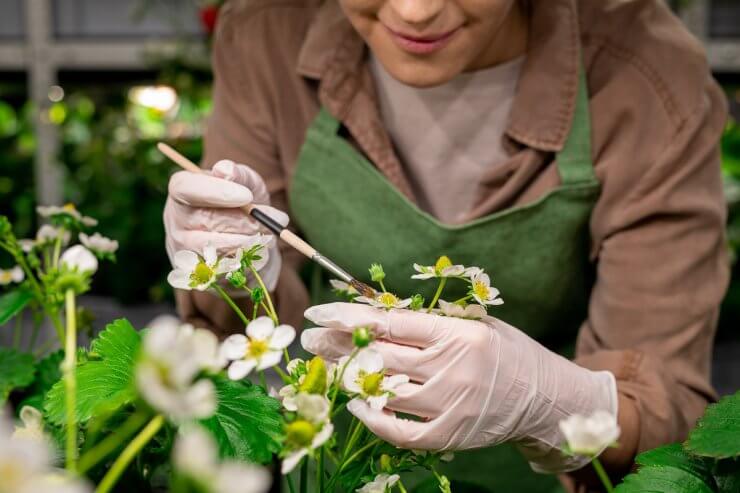
Living in the northeast, I don’t take indoor growing of fruits and vegetables that seriously. I consider it more of a hobby than a sustainable source of produce, and maybe even more of a science experiment. Here are some recent examples: “this winter, can I get a crop of cherry tomatoes before spider mites come in and attack them?” and “can I really get mini eggplants to grow this year, and will this DIY baby trellis be enough?” Figuring out how to pollinate indoor tomatoes was my first venture into the hand-pollinating world, and that was an experiment all in itself—and a fruitful one at that.
Indoor gardening is a whole new ballgame and I’ve definitely learned a lot along the way, particularly with my hydroponic garden. For example, I’ve learned not to introduce any new plants from a garden center—like citrus trees—if you have a perfectly happy indoor garden that is pest-free. Because those garden centers are the COVID superspreader event of the plant world. I have also learned that knowing how to pollinate indoor tomatoes and other fruiting plants is a necessity, even sometimes when it claims to be self-pollinating.
So if you want to get into the wild world of indoor gardening, particularly with fruiting plants, you probably want to know how to pollinate indoor tomatoes and other fruiting plants—and also how to know which ones need pollination. Whether you prefer growing container trees or a hydroponic garden, there are tips and tricks to help your plants thrive.
Discover 7 top tips for growing, harvesting, and enjoying tomatoes from your home garden—when you access the FREE guide The Best Way to Grow Tomatoes, right now!
Jokes and gripes aside, growing fruits and vegetables indoors can be a beneficial endeavor. You (sometimes) don’t have to use insecticides, you have a hobby when the weather is cold, and you get to surround yourself with greenery even when it’s not so green outside.
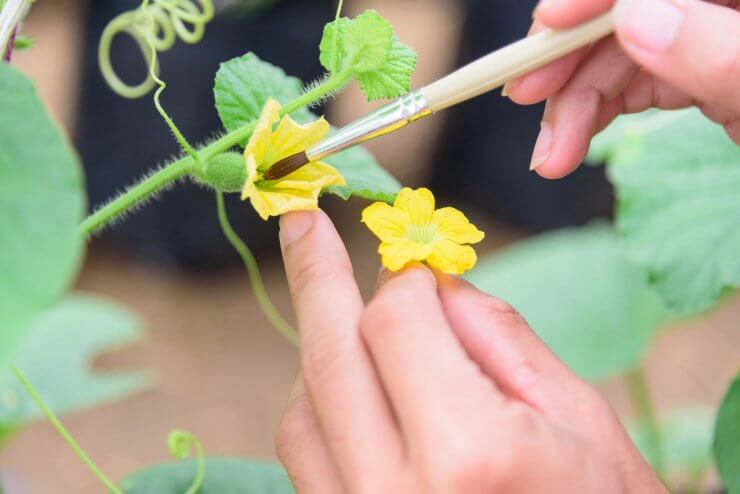
Pollination and indoor plants
If you plan to grow indoor plants, you’ll eventually have to think about pollination at some point.
Sometimes, they need pollen sources to trigger growth, but there’s no one-size-fits-all pollination option for them. When you identify which works best for your garden, it could make a world of difference for your plants.
Let’s check out some of the most common pollination systems below when plants are growing out in the wild.
- Insect pollination: Some plants depend on insect pollinators like bees, ants, and moths.
- Bird pollination: Birds can transfer pollen granuless when they fly from flower to flower. However, unlike insects, they can see well but have a poor sense of smell. Large, bright, odorless flowers attract them.
In both of these pollination systems, pollen needs to be carried. Indoors you can do this with a paintbrush or even a q-tip.
- Wind pollination: Plants without female and male flowers (like oats, corn, and strawberries) don’t need insects to thrive. Instead, they use wind wind to complete the pollination process.
Indoors, this can be mimicked with a small oscillating fan.
What are the two types of plants?
There are two plant types in terms of pollination: self-pollinating plants and cross-pollinating plants. It’s essential to understand each type to learn how to pollinate indoor tomatoes and other food-bearing plants.
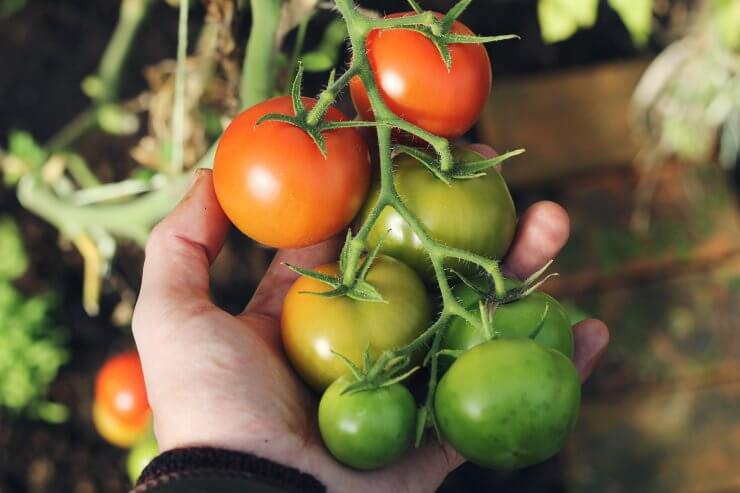
Self-pollinating / self-fertile plants
Self-pollination is the mating system most vegetables and grain crops use. These plants don’t depend on bees or birds for the flower-to-flower pollination process in order to produce fruit.
That said, this term should be taken lightly when grown indoors. They’re considered self-pollinating because outside, even a light gust of wind does the work of pollinating the plants enough to produce fruit. They don’t require an insect or bird to carry pollen around.
Indoors though, they most likely will need assistance to be pollinated. Examples of common indoor self-pollinating / self-fertile plants are:
- Tomatoes
- Legumes / Beans
- Eggplants
- Peppers
- Peas
- Strawberries
- Citrus trees
These plants don’t always need your help to pollinate, but there is an easy way to speed up the process: a fan. Just a small oscillating fan that keeps air flowing in the room. You can also hand-pollinate, which we’ll talk about below.

Cross-pollinating plants
Cross-pollinating plants contain male and female flowers. The male flower carries the stamen and anther, while its female counterpart holds the ovary.
In these plants, the pollen should transfer from the male flower to the female flower to bear fruits and vegetables. You can identify the difference between a male and female flower by the “ovary”. Males have a long thin stem that attaches to the flower, whereas females will have a bulb at the top of the stem between it and the flower.
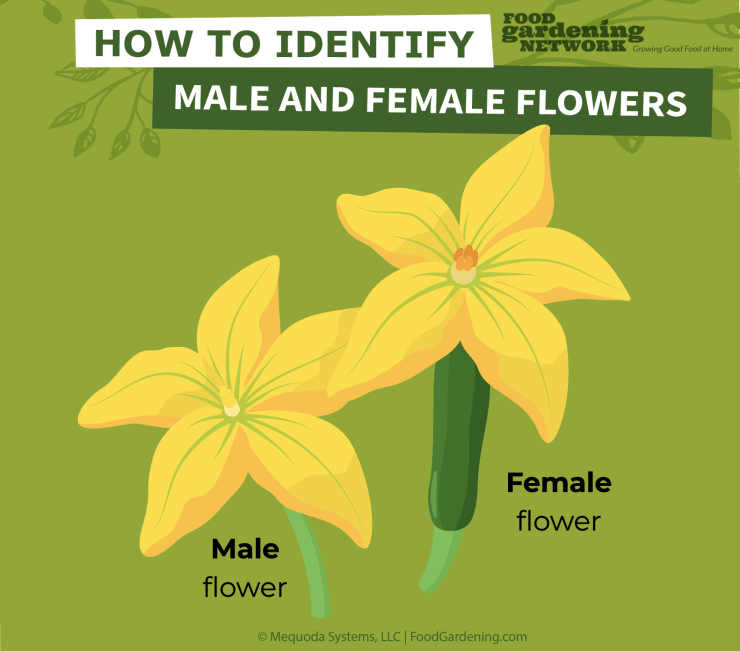
With pollinator-attracting flowers outdoors, it’s easy for these plants to pollinate. However, since there aren’t many bees, birds, and other pollinators inside, these plants need your help to grow.
Examples of common indoor cross-pollinating plants are:
- Cucumbers
- Winter Squash
- Melons
- Summer Squash
- Tomatillos
How to pollinate indoor tomatoes and other plants
This is the fun part — learning how to pollinate indoor tomatoes and other plants! Here are some simple but effective techniques:
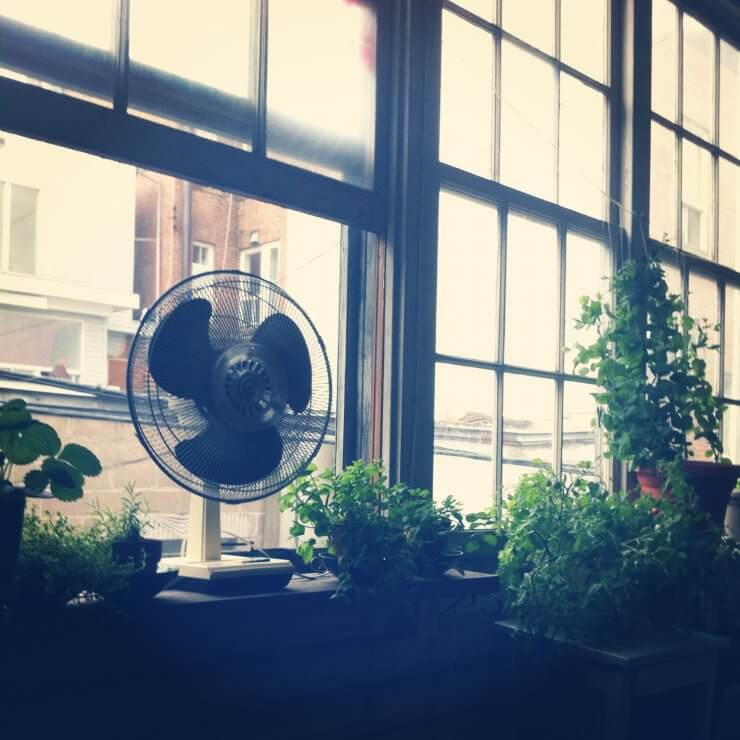
Use a fan
Indoor plants don’t have access to flowing air. If you can’t let a natural breeze in, replicate this effect using a gentle fan. This setup is ideal during winter or other cold seasons since the wind during those months is dry or stagnant.
Set your fan to low, and let it blow gently in one direction. The setting should mimic a natural breeze that can help pollinate your plants. If you’re in a small room or the fan seems too strong, an oscillating fan is better. If your goal is learning how to pollinate indoor tomatoes, this is all you need, however as you’ll see below, there are also opportunities to hand-pollinate if you want to increase your odds.
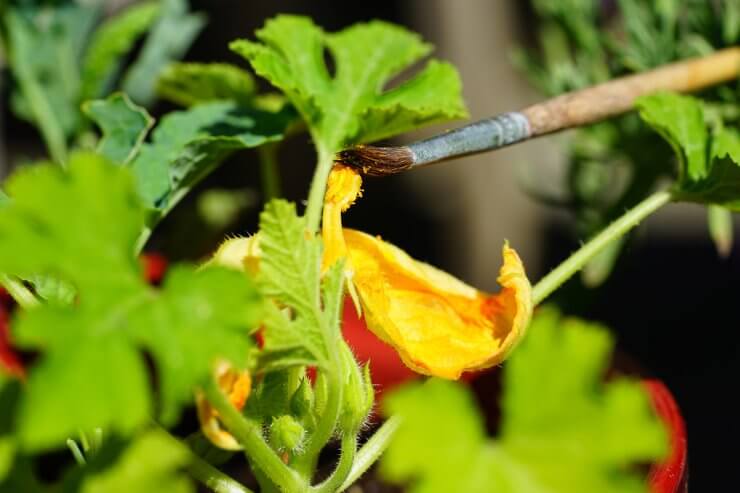
Use a soft brush
For plants with male and female flowers, use a small brush to transfer the pollen into the female flowers. A small paintbrush or a makeup brush with gentle bristles are good candidates. If you don’t have these items, cotton swabs are also suitable alternatives. You can start with a little pollen at first, adding more if necessary.
You can also use this method for self-pollinating plants like tomatoes to increase your chances of fruits. All you need to do is brush all the flowers so the pollen gets down into the middle part of the flower (the pistil).
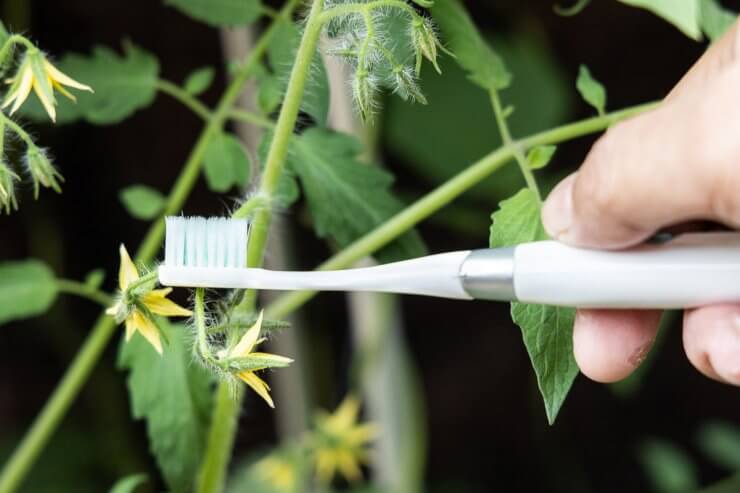
Gently shake the plant
Gently shaking the plant can also help with pollination. You can choose to shake the flowers or the entire plant. You can try this method daily, just as long as you’re not being too rough.
Alternatively, if you’re not too sure about shaking your plants, using an electric toothbrush can have the same effect. The soft vibrations from this device can shake and move the pollen to where it needs to go. You can use this directly on your houseplants, provided they’re clean and not used for anything else. Label your pollinating toothbrush, so you don’t get it mixed up with the one you use on your teeth!
Ready, set, grow!
Pollinating indoor fruits and vegetables can be something to look forward to once you’ve gotten the hang of how it works. Again, patience is key — and so is being gentle with the hand-pollination process. Soon enough, you’ll see your fruits and vegetables growing and ready to harvest!
Do you have your own tips for hand-pollinating and cross-pollinating? Let me know in the comments!
Discover 7 top tips for growing, harvesting, and enjoying tomatoes from your home garden—when you access the FREE guide The Best Way to Grow Tomatoes, right now!





